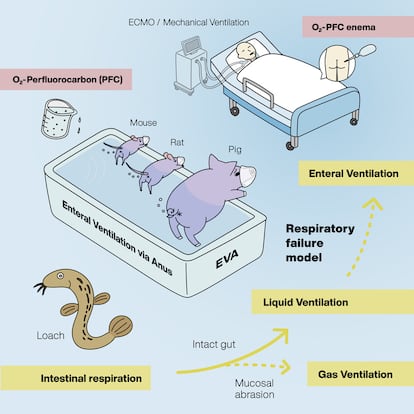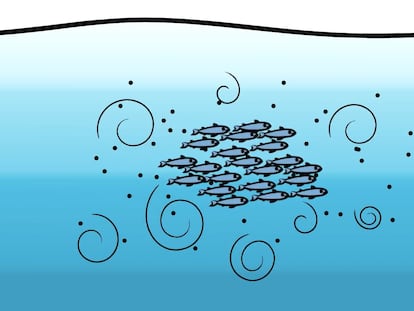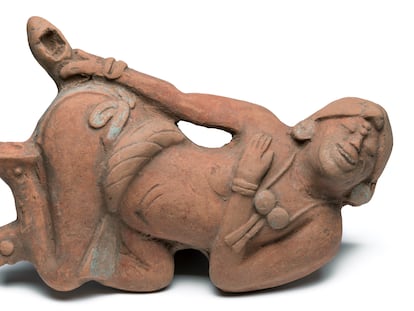Mammals that breathe through their anus and drunk worms: The craziest scientific studies of 2024
The Ig Nobel Prize has awarded unusual achievements in research, such as a paper that proves dead trout ‘swim’ like live fish or that scaring a cow affects its milk production

A Japanese study that found mammals can breathe through their anus is one of the papers recognized by the Ig Nobel Prize, a satirical prize awarded by the Annals of Improbable Research to the most unusual achievements in scientific research. Other prize winners include a study that shows drunk worms are slower than sober ones, research into the swimming patterns of dead trout, and a paper into how scaring a cow every 10 seconds affects its milk, but having a cat on its back does not.
These are the investigations — published in scientific journals — that were awarded an Ig Noble Prize at a ceremony held Thursday at the Massachusetts Institute of Technology, in the presence of five Nobel laureates:
Breathing through the anus
Gas exchange via the traditional mammalian escape route does not have to be unidirectional — from the individual to the environment — leading to the undesirable side effect that is well-known to the flatulent. This is the conclusion reached by Ryo Okabe’s team at Tokyo Medical University. The research was inspired by organisms such as loaches that have developed “unique intestinal breathing mechanisms to survive under extensive hypoxia.” In 2022, the Ig Nobel Prize recognized a work about ritual anal injections by the Maya civilization, but the new research into digestive breathing is a unique angle into this field of study.
The awards recognized the boldness of the work into the “advent of the intestinal breathing phenomenon in mammalians by exploiting EVA (enteral ventilation via anus).” In this situation, oxygen is supplied via the anus or via liquid containing oxygenated perfluorocarbon. So far, the researchers have only experimented with rodents and pigs. But the scientists claim that both procedures, in the case of respiratory failure, can improve survival rate and systemic circulation. According to the study, the side effects are similar to what is experienced after an enema, “with no major signs of complications.” In any case, its possible clinical use could be one more good reason to stop smoking.
Drunk worms are slower
Although the results were to be expected, a team of researchers led by University of Amsterdam’s Tess Heeremans won an Ig Noble Prize “for using chromatography to separate drunk and sober worms.” The experiment, published in Science Advances, consisted of putting several worms — half sober and the other half exposed to a 5% ethanol solution — into a maze. The sober worms completed the maze 50 seconds earlier. The study does not say whether the drunk worms had any accidents along the way.
It’s better if it hurts
To every mother and father who has ever consoled their injured children with the saying: what stings, heals... Well, a Central European study took this idea to the extreme and subjected 77 people to nasal sprays that had no therapeutic effect, but caused thermal pain. Half of the participants were told that it was a treatment. The participants who felt more pain, believed the supposed treatment was more effective. The worse part of this is that the researchers suggest side effects could “trigger positive treatment expectations and enhance treatment outcomes.”
How cows respond to being scared vs a cat
The managers of the experimental farms in Kentucky and Minnesota, not content with testing the effects of administering different substances during milking, decided to explore something new: how cows respond to having a cat on their back and to hearing paper bags burst every 10 seconds. According to the experiment, the cat made no difference to the cows, who could produce milk straight away. However, after being “systematically frightened,” the cows could not produce milk again until 30 minutes after the trauma, “although the gland was still relatively hard, but considerably more relaxed than at the time of frightening,” explain the researchers.
How dead trout swim
James C. Liao, from the Department of Organic and Evolutionary Biology at Harvard University, proposed in The Journal of Experimental Biology a new spin on the raising of Lazarus, focusing on trout. Liao studied how these fish swim depending on the water current. According to the research, the more favorable the current, the less effort is made by the fish, which adopts an inert position to let itself be carried away. In other words, they play dead. What’s most curious about the study is that it compared the inert positions of live fish with the positions of dead trout, reaching the obvious conclusion that: “Live trout head angles have a wider range of values and a higher variance [...] compared with dead trout.”

Pigeons piloting missiles
Psychologist Burrhus Frederic Skinner, who died in 1990, would have personally collected the Ig Nobel if the prize had existed when he reviewed attempts to use animals to guide weapons in World War II. At the time, he warned: “This is the history of a crackpot idea.” The American Psychological Association has won the Ig Nobel — which was collected by Skinner’s daughter — after reviving his 1960 proposal “to use living organisms to guide missiles,” which was included in a wartime research program called Project Pigeon. The idea was abandoned due to the birds’ erratic behavior.
Whorls don’t understand geography
It is difficult to know the global implications of a discovery such as the one made by Department of Medical Genetics at the Montpellier hospital and Chilean scientists: hair of most people in the northern hemisphere curls in the same direction as the hair on the heads of most people in the southern hemisphere. The researchers explained that their motivation for such a momentous discovery was because “the mechanisms determining the laterality and the rotation direction of hair whorls are unknown.”
Looking for random rules
“Many people have flipped coins but few have stopped to ponder the statistical and physical intricacies of the process,” argue the 50 or so authors of a study on coin flips. The number of researchers may seem exaggerated for such a simple study, but considering that they tossed coins 350,757 times, each one was responsible for 7,000 flips. The worst thing is that after all that effort, the result is inconclusive. According to the authors, coins tend to land on the same side they started, only 51% of the time. In other words, half of the time.
Fake centenarians
In the past, people didn’t live longer, they lied better. Saul Justin Newman, from the Department of Population Health at the University of Oxford, has revealed an open secret: there aren’t that many centenarians. Living longer is related to good nutrition, strong social connections and genetic inheritance. But, according to his study, the high number of these centenarians in the past is difficult to confirm. With reliable birth records now readily available, the number of self-declared centenarians has fallen by up to 82%. And the birthdates of the centenarians still on the list are concentrated on days divisible by five: a pattern indicating fraud. Newman suggests that these individuals changed their birthdate to collect their pension years before they were entitled to it. If you want to die early, according to data from Italy, England and France, you only have to live in poverty and in areas that have a high crime rate and low health indices. Sardinia, Okinawa and Icaria are exceptions to this rule, but Newman suspects this is because of age record fraud.
Plants see
Researcher Felipe Yamashita, from the Institute of Cellular and Molecular Botany at the University of Bonn, argues that the hypothesis that plants can see is “plausible.” He defends this in a study in Plant Signaling & Behavior, where he says that the creeper Boquila trifoliolata has the ability to perceive the shapes of its neighboring plants and imitate them, even if they are made of plastic.
Sign up for our weekly newsletter to get more English-language news coverage from EL PAÍS USA Edition
Tu suscripción se está usando en otro dispositivo
¿Quieres añadir otro usuario a tu suscripción?
Si continúas leyendo en este dispositivo, no se podrá leer en el otro.
FlechaTu suscripción se está usando en otro dispositivo y solo puedes acceder a EL PAÍS desde un dispositivo a la vez.
Si quieres compartir tu cuenta, cambia tu suscripción a la modalidad Premium, así podrás añadir otro usuario. Cada uno accederá con su propia cuenta de email, lo que os permitirá personalizar vuestra experiencia en EL PAÍS.
¿Tienes una suscripción de empresa? Accede aquí para contratar más cuentas.
En el caso de no saber quién está usando tu cuenta, te recomendamos cambiar tu contraseña aquí.
Si decides continuar compartiendo tu cuenta, este mensaje se mostrará en tu dispositivo y en el de la otra persona que está usando tu cuenta de forma indefinida, afectando a tu experiencia de lectura. Puedes consultar aquí los términos y condiciones de la suscripción digital.
More information
Archived In
Últimas noticias
Maduro pleads not guilty before the federal court in New York: ‘I am still the president of Venezuela’
A new test can detect Alzheimer’s from a finger prick
UN team enters Sudanese city of El Fasher after paramilitary massacre: ‘It’s like a ghost town’
A recipe for resistance: Indigenous peoples politicize their struggles from the kitchen
Most viewed
- Gilles Lipovetsky: ‘If you want to live better and fall in love, take Prozac, don’t look to philosophy’
- Alain Aspect, Nobel laureate in physics: ‘Einstein was so smart that he would have had to recognize quantum entanglement’
- Alvin Hellerstein, a 92-year-old judge appointed by Bill Clinton, to preside over Maduro’s trial in New York
- Why oil has been at the center of Venezuela-US conflicts for decades
- Maduro’s downfall puts China’s relationship with Venezuela to the test











































